I create this topic to gather information about arms and armor with signs of use, wear, and battle damage. Things that are expected to be posted here:
1) photos
2) historical art
3) descriptions (extracts from books, historical literature, etc.)
4) Results of modern experiments
5) Links to other resources that contain related information
In other words, all pictorial and verbal materials closely related to the subject.
I humbly ask everyone to refrain from asking questions or expressing personal opinion in this thread as I would like this thread to be a kind of database.
Thanks in advance to everyone who adds information to this thread.
There are gobs of examples, but I only have pics of a couple.
Churburg S-18 Gauntlets (these definitely have seen better days)
 Attachment: 73.59 KB
Attachment: 73.59 KB
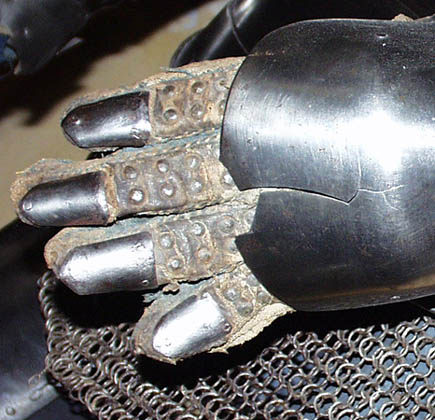
Churburg S-18 Gauntlets (these definitely have seen better days)

Hi.
My first contribute:
A Savoiard helmer - beginning of 1600 - pireced by a "quadrellone da breccia" . The warrior wearing the halmet, was pierced too.
Cesare from Italy
 Attachment: 149.89 KB
Attachment: 149.89 KB

 Attachment: 160.39 KB
Attachment: 160.39 KB
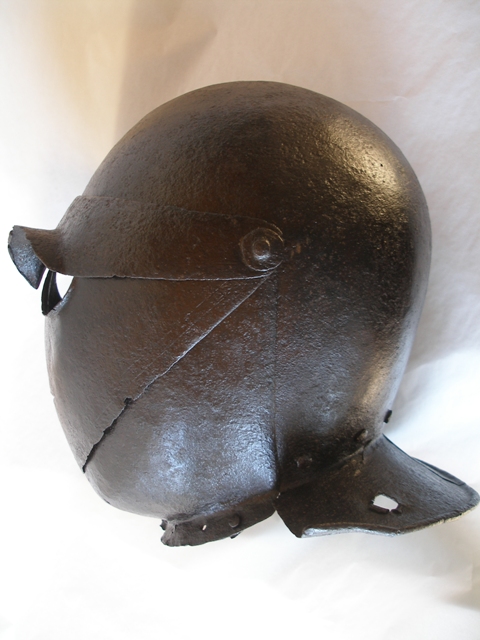
 Attachment: 140.36 KB
Attachment: 140.36 KB
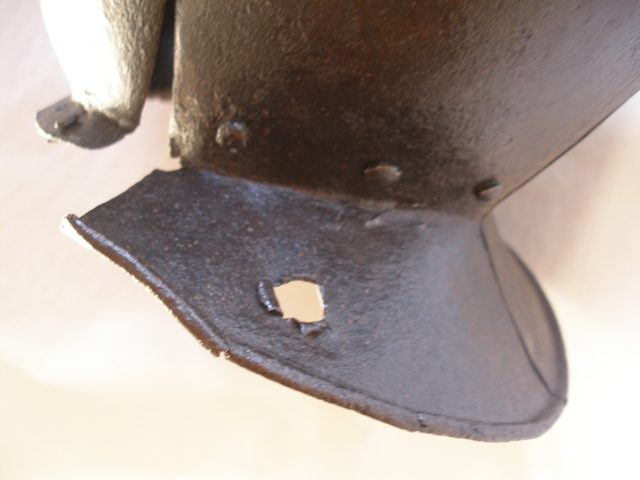
My first contribute:
A Savoiard helmer - beginning of 1600 - pireced by a "quadrellone da breccia" . The warrior wearing the halmet, was pierced too.
Cesare from Italy



| Cesare Paganini wrote: |
| Hi.
My first contribute: A Savoiard helmer - beginning of 1600 - pireced by a "quadrellone da breccia" . The warrior wearing the halmet, was pierced too. Cesare from Italy |
This is the only thing I found for "quadrellone da breccia" that had a perfect match. Couldn't have been that if it pierced him and managed to come out the other side, judging from the way the steel flares out around the hole.
What kind of weapon is the quadrellone da breccia?
M.[/img]
| M. Eversberg II wrote: |
| What kind of weapon is the quadrellone da breccia? |
It's the Italian name of the Ahlspiess, as written here. I think your image was wrongly associated to the words by the search engine as it is on another page that contains the terms. I guess the name comes from the square section of the long pike on this weapon.
More pictures in this thread.
| M. Eversberg II wrote: | ||
This is the only thing I found for "quadrellone da breccia" that had a perfect match. Couldn't have been that if it pierced him and managed to come out the other side, judging from the way the steel flares out around the hole. What kind of weapon is the quadrellone da breccia? M.[/img] |
The "quadrellone da breccia" is an infantery pole veapon, very simple,.Its blade has a square section
Sorry. My english is very bad and I don' know the English name of "quadrellone".
For a better description, I attach some pictures of a sixteenth century quadrellone, from "my" museum, near Verona (Italy)


[It's the Italian name of Ahlspiess
Thanks. Ahlspiess may be the weapon who caused the elmet pearce .
But the Ahlspiess is quite different by quadrellone.
Here is some pictures of an ahlspiess remains, present in medieval weapons collection of "my" museum.
Cesare
 Attachment: 57.01 KB
Attachment: 57.01 KB

 Attachment: 113.63 KB
Attachment: 113.63 KB
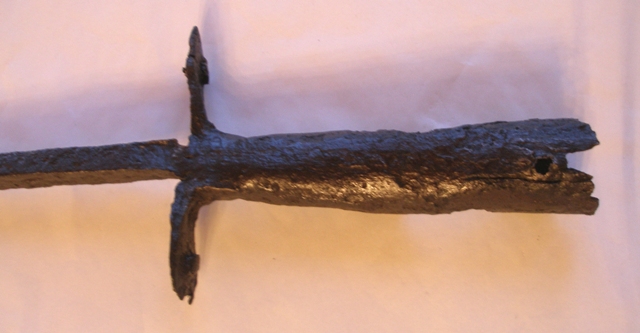
Thanks. Ahlspiess may be the weapon who caused the elmet pearce .
But the Ahlspiess is quite different by quadrellone.
Here is some pictures of an ahlspiess remains, present in medieval weapons collection of "my" museum.
Cesare


"Quadrellone" as Caesar said it was a square blade,
to push one's way through the crowd.
Breccia = to find the way, breach, corridor in to enemy
to push one's way through the crowd.
Breccia = to find the way, breach, corridor in to enemy
Well, the everlasting wonders of pole weapons terminology ;) Whatever the exact name is I think the shape of the business end is pretty clear now :)
| Aleksei Sosnovski wrote: |
| I create this topic to gather information about arms and armor with signs of use, wear, and battle damage. Things that are expected to be posted here:
1) photos 2) historical art 3) descriptions (extracts from books, historical literature, etc.) 4) Results of modern experiments 5) Links to other resources that contain related information In other words, all pictorial and verbal materials closely related to the subject. I humbly ask everyone to refrain from asking questions or expressing personal opinion in this thread as I would like this thread to be a kind of database. Thanks in advance to everyone who adds information to this thread. |
Here are a couple of pictures...
ks
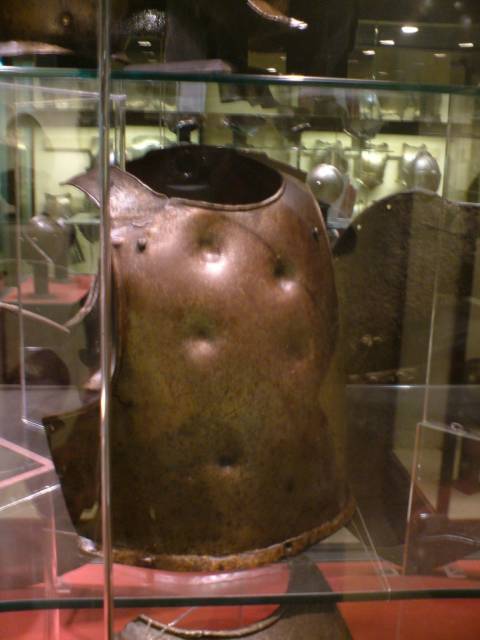
Palace Armouries in Valetta. 1650
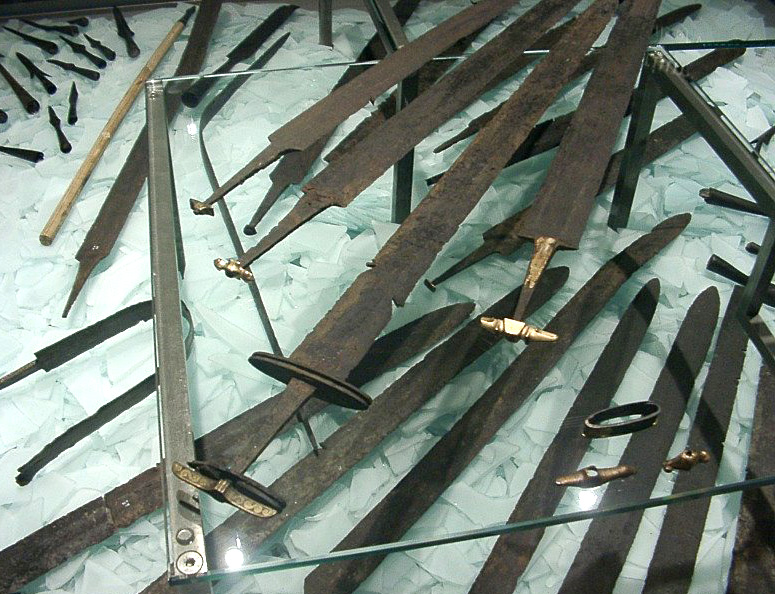
May not be battle damage but part of the ritual "killing" of the sword.
Look at the cuirass near the bottom of this article:
http://www.wtj.com/articles/napart/
Now that's what I call battle damage.
http://www.wtj.com/articles/napart/
Now that's what I call battle damage.
Courtesy of Cesare Paganini as well, with whom I spent a very interesting afternoon.
Consolidation work of this skullcap was made by Cesare, there is not enough metal under the concretion layer to justify a removal, the artifact would likely crumble, so it must remain in this state.
http://bghomofaber.googlepages.com/catepiscina058.jpg
Consolidation work of this skullcap was made by Cesare, there is not enough metal under the concretion layer to justify a removal, the artifact would likely crumble, so it must remain in this state.
http://bghomofaber.googlepages.com/catepiscina058.jpg
On a related issue,
How much damage could a sword sustain before it would be deemed useless, or at least no longer a vialble battle weapon. How many dents, chips, etc... could a sword blade sustain before it had to be replaced?
I have heard a sword blade is permanently weakened when it is struck blade to blade, and it nicks; that microscopic hairline fractures branch off from the nick/dent and weaken the blade.
I have a "beater" sword from windlass that has absorbed lots of nicks and dents, purposefully. But it would absolutley be useful in a fight, and still seems stout.
Thoughts???
How much damage could a sword sustain before it would be deemed useless, or at least no longer a vialble battle weapon. How many dents, chips, etc... could a sword blade sustain before it had to be replaced?
I have heard a sword blade is permanently weakened when it is struck blade to blade, and it nicks; that microscopic hairline fractures branch off from the nick/dent and weaken the blade.
I have a "beater" sword from windlass that has absorbed lots of nicks and dents, purposefully. But it would absolutley be useful in a fight, and still seems stout.
Thoughts???
Page 1 of 1
You cannot post new topics in this forumYou cannot reply to topics in this forum
You cannot edit your posts in this forum
You cannot delete your posts in this forum
You cannot vote in polls in this forum
You cannot attach files in this forum
You can download files in this forum
All contents © Copyright 2003-2006 myArmoury.com — All rights reserved
Discussion forums powered by phpBB © The phpBB Group
Switch to the Full-featured Version of the forum
Discussion forums powered by phpBB © The phpBB Group
Switch to the Full-featured Version of the forum